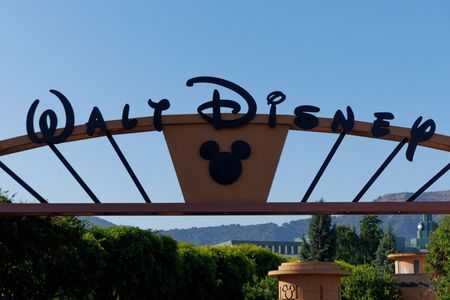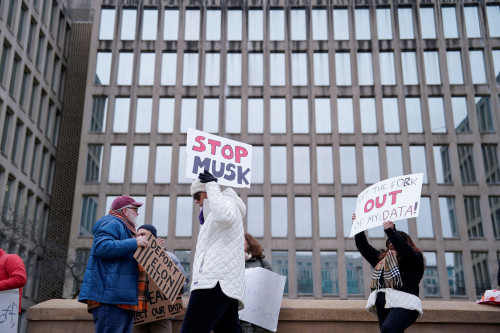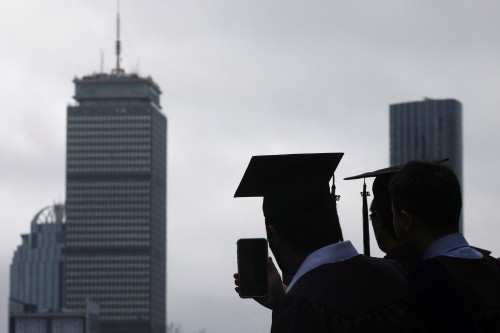By Dawn Chmielewski
(Reuters) -Walt Disney CEO Bob Iger acknowledged that the entertainment company faces a “challenging environment” in the near term on Wednesday, but he emphasized progress in cutting costs and focusing on creativity, even as quarterly results showed Disney’s soft spots.
Disney’s stock rose nearly 3% in after-hours trading, as Iger touted $1 billion in operating-income improvement at the company’s streaming business over the last three quarters, which is aiming for profitability in 2024.
But he also acknowledged the need to improve the quality of Disney’s films, to position the company’s flagship sports brand, ESPN, for streaming directly to consumers, and to resolve the writers’ and actors’ strikes in Hollywood that have halted muchfilm and television production.
“I returned to Disney in November, and I’ve agreed to stay on longer, because there was more to accomplish before our transformation is complete,” Iger said, describing a “challenging environment in the near term.”
The company beat Wall Street’s profit expectations for its fiscal third quarter and said it was on track to cut costs by more than the $5.5 billion it promised investors in February.
Disney also posted quarterly revenue below expectations and fell slightly behind analyst projections for U.S. subscribers of Disney+.
The media conglomerate said it will raise by 27% the price of the ad-free tier of the Disney+ service to $13.99 and hike by 20% the no-ad version of Hulu.
Looking for ways to attract and retain subscribers in a competitive streaming market, Disney also announced it would launch ad-supported streaming in Europe and Canada and provide U.S. subscribers with a new, ad-free package in coming months.
Iger said he would address the issue of password sharing next year, echoing Netflix.
He said Disney will reduce the number of titles it releases and also the cost per title.
REVENUE JUST MISSES
Disney said it cut losses at its streaming video services to $512 million in its fiscal third quarter from about $1.1 billion a year ago.
It added 800,000 Disney+ subscribers, 100,000 subscribers shy of analyst estimates, and shed 12.5 million subscribers to the Disney Hotstar service in India, or nearly a quarter of its subscribers, as it gave up rights to Indian Premiere League cricket matches.
“Disney will have to cut prices from current levels in an effort to stimulate demand and defend its market share in an increasingly competitive industry,” said Jesse Cohen, senior analyst at Investing.com.
Disney’s revenue for the quarter ended July 1 rose 4% to$22.33 billion from a year earlier, just short of Wall Street estimates, according to Refinitiv. It delivered per-share earnings of $1.03, when excluding certain items, beating Wall Street projections of 95 cents a share.
The company took $2.65 billion in impairment and restructuring charges in the quarter, reflecting the cost of removing some content from its streaming services, terminating licensing agreements and $210 million in severance payments to laid-off workers.
Disney’s traditional television business continued its decline. Higher sports programming production costs and lower affiliate revenue dragged down the performance of its cable channels. TV revenue fell 7% to $6.7 billion, while operating income fell 23% to $1.9 billion.
Disney’s direct-to-consumer business reported a 9% increase in revenue to $5.5 billion, as the average revenue per subscriber rose at Disney+ and Hulu.
Content sales and licensing, the unit that includes film and television sales, reported a deeper operating loss of $243 million in the quarter, compared with a loss of $27 million a year ago, as some movies disappointed, including the live-action remake of “The Little Mermaid”.
Disney’s Parks, Experiences and Products group reported a 13% increase in revenue in the quarter, to $8.3 billion, and an 11% bump in operating income to $2.4 billion. The results were buoyed by the rebound of the Shanghai Disney Resort, which was open for the full quarter compared with the same time a year ago, when COVID-19 forced the park to be closed for all but three days. The unit had lower operating income at its domestic parks, due to decreases at Walt Disney World Resort in Orlando, Florida.
(Reporting by Dawn Chmielewski in Los AngelesAdditional reporting by Chavi Mehta and Aditya Soni in BengaluruEditing by Peter Henderson, Sayantani Ghosh and Matthew Lewis)








